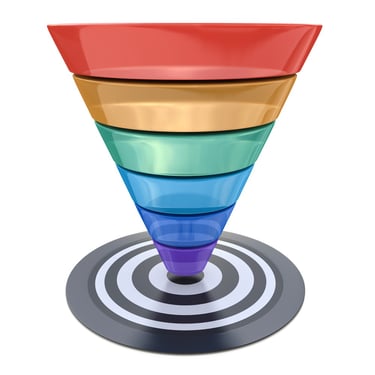 In many ways, the digital age has made the sales process easier than ever before. At the same time, though, that also means that your company needs to learn all the different ways they can convert prospects into customers. Otherwise, you won’t just be leaving business on the table; you’ll be providing your competition with an express route to passing you by.
In many ways, the digital age has made the sales process easier than ever before. At the same time, though, that also means that your company needs to learn all the different ways they can convert prospects into customers. Otherwise, you won’t just be leaving business on the table; you’ll be providing your competition with an express route to passing you by.
One method everyone has to know about for securing business is a sales funnel. Yet, roughly two-thirds of BSB organizations haven’t identified theirs, which means they’re actively handicapping their ability to bring in more leads.
What is a sales funnel?
Technically, every company uses a sales funnel. Even those companies we mentioned that haven’t identified theirs are using one if they are attracting customers and selling to them. Not understanding them, though, is why they don’t have the results they want.
A sales funnel is just a visual model of the steps necessary to make a sale. Most versions of the funnel involve three parts: the top, middle and bottom.
Top of the funnel
The top of your funnel (TOFU) represents the initial steps involved with making a sale. This is at the very beginning where you have potential customers out there just beginning to research whom they should go to with a specific problem of theirs.
 At this point in the funnel, your prospects don’t need to be educated on your solution. Instead, you want to be cultivating them by helping them better understand their unfulfilled needs.
At this point in the funnel, your prospects don’t need to be educated on your solution. Instead, you want to be cultivating them by helping them better understand their unfulfilled needs.
This is also where inbound marketing and SEO tactics help. You need to bring prospects into the fold and give them a reason to hang around so you can then proceed to educate them on their problem.
Middle of the funnel
Next, we have the middle of the funnel or MOFU. This section is all about evaluation. It’s when the prospect now understands that they have a problem—and all that it entails—and appreciates that your company is at least an option for solving it.
Now your job is to help the prospective customer make the decision that your company is by far the right one to help them with this need of theirs. This is where your sales tactics kick in for closing the deal.
New #data on what works and what doesn't in the #B2B sales funnel, from @HubSpot. http://t.co/ShMiwZcldD pic.twitter.com/iI9qlixySL
— GoodData (@gooddata) January 8, 2015
Bottom of the funnel
Finally, we reach the bottom of the funnel. BOFU is where you get the lead to sign on the dotted line and become an official customer of your company. You do this by incentivizing them to take action now, not sometime in the future if they get around to it.
Optimizing your Sales Funnel
Every company is going to have a different sales funnel, though the above should remain the same. This means that it’s up to you to explore and test what will work best for your unique business. When it comes to TOFU, you’ll want a website obviously. You’ll also want some content for your prospects to read. However, think about all your options for this. White papers, case studies and eBooks are three good examples.
Helping visitors identify your business as the right one for them might mean a free consultation. Closing the deal could be easier if you gave them something else for free, like the initial parts of the solution they need.
The sales funnel exists whether you’ve intentionally designed yours or not. The problem is that too many companies don’t take the time to sit down and think about what theirs should entail. With the above information, you now have the knowledge you need to take control of this important approach. 


 BACK TO ARTICLES
BACK TO ARTICLES 

